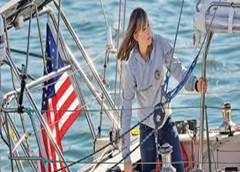题目内容
The Atlantic Ocean ________ America ________ Europe.
- A.divides …from
- B.divides … into
- C.separates … and
- D.separates …from

 智能训练练测考系列答案
智能训练练测考系列答案Below are descriptions of six famous states in the U. S.
California is a state located on the West Coast of the United States. It is the most populous U.S. state and was admitted as the 31st state on September 9, 1850.California's diverse geography ranges from the Pacific Coast in the west, to the Sierra Nevada mountains in the east. Earthquakes are a common occurrence due to the state's location along the Pacific Ring of Fire: about 37,000 are recorded annually. The California Gold Rush happened in San Francisco and there is also a famous Silicon Valley. Hollywood exists in Los Angeles, making it the center of entertainment. “The Golden State” has long been a popular designation for California and was made the official State Nickname in 1968.
Florida is a state in the southeastern region of the United States, bordered to the west by the Gulf of Mexico, to the north by Alabama and Georgia and to the east by the Atlantic Ocean. Miami is the largest metropolitan area in the southeastern United States.The climate varies from subtropical in the north to tropical in the south. Its economy relies mainly on tourism, agriculture, and transportation. Florida is also known for its amusement parks, the production of oranges, and the Kennedy Space Center. Florida has attracted many writers such as Marjorie Kinnan Rawlings, Ernest Hemingway and Tennessee Williams, and continues to attract celebrities and athletes. It is internationally known for golf, tennis, auto racing, and water sports.
Utah is a state in the Western United States. It became the 45th state admitted to the Union on January 4, 1896. Utah is the most religiously homogeneous state in the Union. Approximately 63% of Utahans are reported to be members of The Church of Jesus Christ of Latter-day Saints or LDS, which greatly influences Utah culture and daily life. The state is a center of transportation, education, information technology and research, government services, mining, and a major tourist destination for outdoor recreation.
Texas is the second most populous and the second-largest of the 50 states in the United States of America. Houston is the largest city in Texas and the fourth-largest in the United States. Texas is nicknamed the Lone Star State to signify Texas as a former independent republic and as a reminder of the state's struggle for independence from Mexico. The "Lone Star" can be found on the Texas state flag and on the Texas state seal today. The term "six flags over Texas" came from the several nations that had ruled over the territory. In 1845 it joined the United States as the 28th state. One Texas industry that thrived after the Civil War was cattle. Due to its long history as a center of the industry, Texas is associated with the image of the cowboy.
Virginia, is a U.S. state located in the South Atlantic region of the United States. Virginia is nicknamed the "Old Dominion" and the "Mother of Presidents" after the eight U.S. presidents born there. It is unique in how it treats cities and counties equally, manages local roads, and prohibits its governors from serving consecutive terms. Virginia's economy has many sectors: agriculture in the Shenandoah Valley; federal agencies in Northern Virginia, including the headquarters of the Department of Defense and CIA; and military facilities in Hampton Roads, the site of the region's main seaport. Virginia's public schools and many colleges and universities have contributed to growing media and technology sectors. As a result, computer chips have become the state's leading export.
Kentucky, is a state located in the east south-central region of the United States. In 1792 it became the 15th state to join the Union. Kentucky is known as the "Bluegrass State", a nickname based on the bluegrass found in many of its pastures because of the fertile soil. It is a land with diverse environments and abundant resources, including the world's longest cave system, Mammoth Cave National Park, the greatest length of navigable waterways and streams in the contiguous United States, and the two largest man-made lakes east of the Mississippi River.Kentucky is also home to the highest per capita number of deer and turkey in the United States.
【小题1】 Which state is called the “golden state” and why?
| A.California, because of the gold rush. |
| B.Texas, because of the stars there. |
| C.Virginia, because of a famous mother there. |
| D.Kentucky, because of the famous “KFC” there. |
| A.Virginia | B.Texas | C.California | D.Florida |
| A.California – Utah—Texas – Kentucky |
| B.Kentucky–Texas – California – Utah |
| C.Kentucky–California – Texas —Utah |
| D.California –Kentucky—Texas –Utah |
| A.Cowboys in Texas. |
| B.Utah and religions. |
| C.Hollywood in Virginia. |
| D.Kennedy Space Center in Florida. |

One of my most unforgettable experiences is the day I finished my tough rowing and keep myself free of loneliness.
As the youngest female ever to row alone across the Atlantic Ocean, I was often asked the same question: How did you, a only 20-year old youngster row a 18-foot boat for 70 days through those strong winds and violent waves and survive?
Frankly speaking, for me, the physical challenge was not the greatest one. Before I made my mind to row across the Atlantic, I had already cycled 3,300 miles, run all by myself across the Mojave Desert, and swum the 325-mile length of the Allegheny River. No, the hardest part would be mental: How would I cope with the terrible loneliness and the boredom on the vast sea for such a long time?
I set out on January 1 and my first object was to swim past the quarter-way mark, which would take about 20 days. I made it on January 20, a gray and cloudy day. I had thought to do something to celebrate my first goal such as treating myself to a chocolate bar or something else. But I didn’t. I was suffering from unbearable boredom and loneliness of the long sea journey. I hadn’t seen any landing at least more than two weeks. It seemed to feel the same every day. Eating, rowing, sleeping, staring at the sky, watching the ocean.
Then that day came! It was around dusk, I noticed something move on the horizon. Yes, some dolphins! They approached me and circled my boat. Suddenly I felt so blessed. They had arrived to accompany me and helped to celebrate, just when I needed them so badly! For the next 15 minutes, I did row at full speed with all my strength with those lovely dolphins around. By the time they were to leave me and we went our separate ways, I was no longer lonely.
After 70 days and five hours at sea, I finally reached my final destination. I was proud that I made it, all 2,817 miles, which helped to raise $70,000 for the Blue Planet Run Foundation, an organization for funding drinking water. I’ve been told some athletes struggled to get through just by imagining the end during the whole process. But for me, what makes miracle is to focus your mind on the moment, where you experience the personal growth—those moments of awareness of being connected to the sun, the weather, and the waves. And, on the best day of my life, I had to admit those dolphins really freed myself from terrible loneliness.
【小题1】Which of the following belongs to part of preparation for the row?
| A.Answering the same question raised by people |
| B.Swimming the 325-mile length of the river |
| C.Running 3,300 miles cross-country |
| D.Biking across the Mojave Desert |
| A.I wasn’t in the mood to celebrate my first goal |
| B.I didn’t have any chocolate bar for energy |
| C.It’s a pity not to celebrate my passing the quarter |
| D.It’s a pity not to treat myself to a chocolate bar |
| A.The Blue Planet Run Foundation helped me a lot. |
| B.The dolphins accompanied me to reach my destination |
| C.The unexpected dolphins swept away my loneliness |
| D.Imagination was a useful way to help me get through |
| A.The only challenge for a 20-year old |
| B.Tips on handling loneliness at sea. |
| C.How to row alone across the Atlantic |
| D.The day I stopped being lonely |